The “Khrustik” cucumber hybrid, popular among summer residents, has a juicy crunch and excellent taste.
Cucumber hybrids have earned the love of gardeners due to their productivity and resistance to the most dangerous diseases of the pumpkin family. They do not require careful care, ripen quickly and have an attractive presentation. Among the most popular hybrids is the Khrustik cucumber.
Description of cucumbers
Khrustik f1 is a hybrid that was bred in the early 2000s by Moscow breeders. Khrustik is suitable for growing in a greenhouse or in open ground under film. In open ground the result will be better, since this hybrid is characterized by the formation of many lashes.
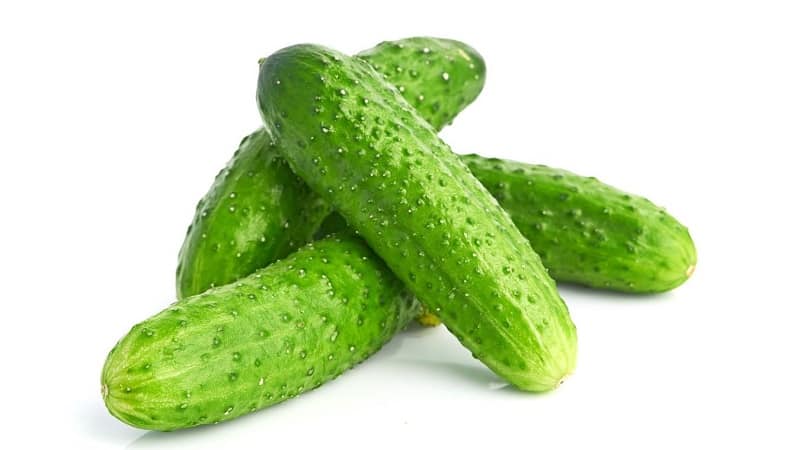
Khrustik is generally thermophilic: It is preferable to grow it in the southern regions of the country. In cold climates, yields may fall and plants will become sick more often.
This is an early cucumber hybrid, from the appearance of the first shoots to the start of fruiting, approximately 44-48 days pass.
Important! Hybrid Khrustik is parthenocarpic. The fertilization process occurs without the participation of male pollen and bees.
Distinctive features
Culture has the following distinctive features:
- The plant itself is powerful and develops quickly.
- Does not suffer from diseases typical of cucumbers, such as powdery mildew, cucumber mosaic or root rot.
- Loves sunlight.
- Friendly germination for a period of 7 days.
Composition, properties, benefits, calorie content
When consumed correctly and in moderation, cucumbers only bring health benefits., are sometimes used in the treatment of diseases.Most of the cucumber (95%) is structured water, beneficial for the body. In addition to it, the composition includes potassium (141 mg per 100 g), iodine, calcium (23 mg per 100 g), magnesium (14 mg per 100 g), necessary for the coordinated functioning of the heart, B vitamins, and a whole list of minerals:
- sodium;
- fluorine;
- molybdenum;
- aluminum;
- cobalt;
- zinc;
- copper;
- manganese;
- chlorine;
- chromium.
Substances contained in cucumbers stimulate digestion and improve intestinal motility. In addition, cucumbers, due to their large amount of fiber, help eliminate harmful substances and toxins from the body.
Due to their low calorie content, cucumbers are considered a dietary food., and their use is encouraged if you need to lose weight. 100 g of cucumber contains only 14 kcal, so feel free to add this healthy vegetable to your diet.
Characteristics
The bushes are branched and are not limited in growth. The length of the fruit can reach 10 cm, and its weight can reach 110 g.. The leaves of the cucumber are large in size and dark green in color. The fruits of Khrustik have an oval-cylindrical shape, slightly pointed at the tips. The peel is thin, dark green. White stripes and tubercles can be seen on the surface of cucumbers.
The taste of cucumber is mild and has no bitterness.. The fruits are fragrant and sweet. The hybrid got its name for its juicy crunch. Any gardener will be pleased with the fact that up to 11 kg of harvest can be obtained from one bush.
In the photo - cucumber Khrustik f1.
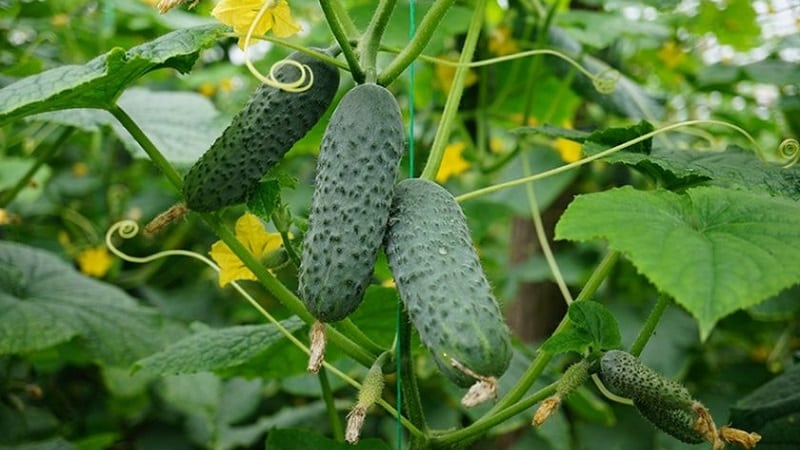
How to grow your own
Since the hybrid is quite thermophilic, it recommended to grow in warm and sunny regions of the country. Gardeners in the northern regions can also grow Khrustik, but they should choose the most sunny and protected from drafts for planting and use film shelters.
Attention! Give preference to those places in the garden where the shade takes up no more than 2 hours of daylight.
The bushes grow branchy, so you need to plant plants according to the 50x50 pattern. Closely planted bushes will not produce enough harvest.
Planting by seeds and seedlings
You can plant Khrustik either as seedlings or directly into the ground.. The seedling method speeds up harvesting by 1-2 weeks.
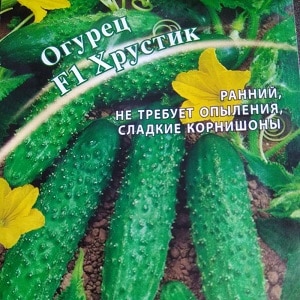 Direct method:
Direct method:
- Planting begins in late spring, in mid-May.
- The soil must be prepared before planting seeds. It should be loose, moist, breathable. Aeration can be achieved using sawdust.
- Direct sowing is only possible in well-warmed soil. Its temperature should not be lower than +12 °C.
- The seeds are lowered into prepared holes 2-3 centimeters deep. The landing pattern is 50x50.
- Then the soil is covered with a film on top until the first shoots appear.
To speed up plant growth, use seedling planting.:
- Seedlings are planted in open ground at the end of May.
- 20-30 days before planting in open ground or a greenhouse, the seeds are sown in separate pots or a common container.
- Then the sprouts are planted on the bright side of the site and maintained at a comfortable temperature of about 25°C.
About other cucumber hybrids:
Meringue hybrid, resistant to diseases and weather conditions
Growing and care
As soon as the first shoots appear, the film can be removed from the ground during the daytime.Cover the cucumbers at night until the air temperature stabilizes.
Basic rules of care:
- Plants need timely loosening and removal of weeds.
- Watering should be regular. It is best to use water warmed in the sun.
- To reduce humidity, remove lower leaves.
- Fertilizing is applied strictly at the root of the cucumber, 2-3 times a month, alternately with mineral and organic fertilizers.
- For better lighting, plants in greenhouses are tied up and grow into one stem.
- Lighting is optimized using a mirror or foil opposite the seedlings.
- Don't forget to humidify the air. Place a bucket of water near the plants or use a spray bottle.
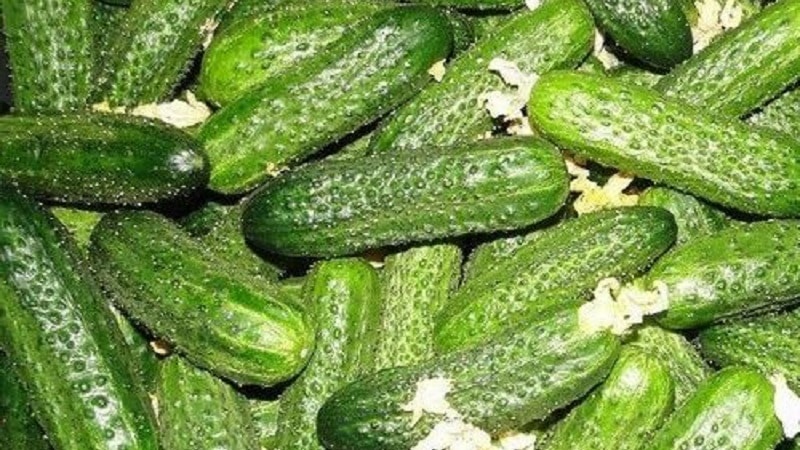
Features of cultivation and possible difficulties
When growing, pay special attention irrigation technique cucumber. The peculiarities of watering are that Khrustik needs to be actively watered during the formation of ovaries and at the initial stage of fruiting. After this, the number of waterings is reduced.
Gardeners recommend using root fertilizers. To achieve ventilation of the rhizomes, remove the lower leaves of the plant.
Characteristic diseases and pests, resistance
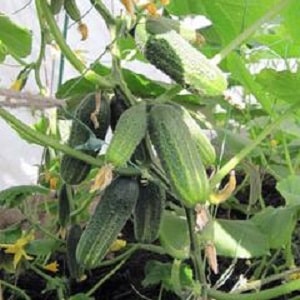 The hybrid is famous for its resistance to popular cucumber diseases. It does not suffer from diseases such as cucumber mosaic or root rot. One of its few drawbacks is that it does not resist downy mildew well.
The hybrid is famous for its resistance to popular cucumber diseases. It does not suffer from diseases such as cucumber mosaic or root rot. One of its few drawbacks is that it does not resist downy mildew well.
As for pests, Khrustik is not protected from them in any way. Here are the most famous pests:
- Spider mite. Light yellow or white spots on the leaves that subsequently take over the entire leaf, causing it to dry out, are considered a sign of spider mites. It often appears on cucumbers. Another sign is a thin web intertwining the foliage.In parallel with weaving the web, the mite pierces the leaf of the plant and drinks its juice. The insidiousness of the tick lies in the fact that due to its small size, about 1/2 mm, it is almost impossible to notice it with the naked eye.
- melon aphid. The adult aphid overwinters on the leaves of weeds. In spring and until the end of summer he lives there. Then, with the help of ants, the pest moves to the back side of the plant leaf.
Harvesting and application
To ensure a rich harvest, at the first stage of fruiting, pick ripe cucumbers as often as possible.
Due to their mild taste, Khrustik cucumbers are consumed fresh, added to salads or okroshka. They are great for pickling and tomato sauces. Experts consider the hybrid to be the best for pickling and preservation..
Advantages and disadvantages
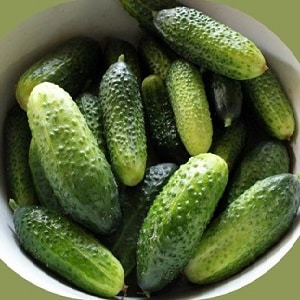 Among the advantages of the hybrid, gardeners and breeders note the following:
Among the advantages of the hybrid, gardeners and breeders note the following:
- ripens early;
- does not lose its presentation for a long time;
- has excellent taste;
- high yield - with proper care from one bush - up to 11 kg of yield per square meter. m;
- practically does not form barren flowers;
- resistant to viral diseases;
- resistant to sudden temperature changes.
The hybrid has several disadvantages:
- due to excessive light-loving nature, Khrustik has a hard time tolerating shade;
- sensitive to soil drying out;
- susceptible to attack by pests, easily affected by aphids and spider mites;
- Since this is not a variety, but a hybrid, self-collection of seeds is excluded.
Reviews
Many gardeners plant Khrustik and happily share their successes in growing it:
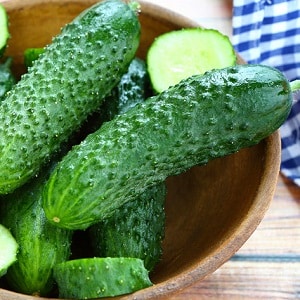 Evgenia, Moscow: “I’ve been planting the Khrustik cucumber for 3 years now. I really like it both fresh and pickled. It always turns out sweet and crunchy. I collect small fruits.Even if they outgrow, they remain crunchy with small seeds. They bear fruit abundantly. The ovaries are arranged in bunches. I usually collect every other day, this stimulates the growth of new ovaries. The seeds have 100% germination all three years. This year, too, out of 10, all 10 sprouted. I sow with dry seeds. Some are for seedlings in pots at the end of April, some are for warm beds at the beginning of May. Cucumber Khrustik is resistant to diseases. And even in unfavorable conditions, with cold weather and sudden temperature changes, it produced a harvest.”.
Evgenia, Moscow: “I’ve been planting the Khrustik cucumber for 3 years now. I really like it both fresh and pickled. It always turns out sweet and crunchy. I collect small fruits.Even if they outgrow, they remain crunchy with small seeds. They bear fruit abundantly. The ovaries are arranged in bunches. I usually collect every other day, this stimulates the growth of new ovaries. The seeds have 100% germination all three years. This year, too, out of 10, all 10 sprouted. I sow with dry seeds. Some are for seedlings in pots at the end of April, some are for warm beds at the beginning of May. Cucumber Khrustik is resistant to diseases. And even in unfavorable conditions, with cold weather and sudden temperature changes, it produced a harvest.”.
Olga, Bryansk: “With the arrival of cold August nights, all the cucumbers in the open ground got sick and gradually died. Khrustik was also sick, and also caught a spider mite, but I removed the diseased leaves, and he grew new ones. It continued to bear fruit until the beginning of October. True, in the fall I didn’t take good care of it and didn’t feed it. The cucumber has an excellent taste, there was no bitterness, the greens were small and did not overgrow. I was pleased with both the taste and its resistance to adverse conditions. Since seeds are not collected from the hybrid, I bought it again this year.”.
Conclusion
Due to its unpretentiousness in planting and care, the hybrid is deservedly considered one of the most beloved among gardeners. It grows well both in a greenhouse and in open ground. Its early ripeness is especially valued in regions with short and cold summers. Khrustik will delight you with a rich and high-quality harvest.
The taste qualities of Khrustik also cannot be ignored - the cucumber is suitable for salads, okroshkas, pickles, and in jars it remains as crunchy as fresh.